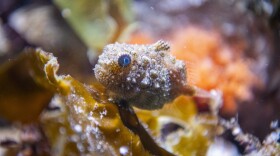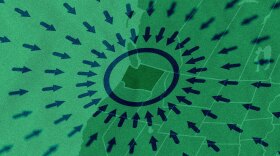Robots are everywhere these days. They’re working in factories, and are the focus of student competitions. They are also teaching us about nature, especially in the case of robotic fish.
It might seem a little Hollywood to talk about "robo-fish." And as an engineering professor, Kristi Morgansen is a little shy about that.
“We usually call them fish robots, or robotic fish,” she said.
The robotic fish Morgansen invented are about the size of a salmon and shaped like one, in a crude way. They’re made from metal and plastic screwed together, with the sophisticated parts on the inside.

“It has this pressure sensor on the side, and on the inside, it has a compass. It can make its way around and sense its own environment," said doctoral student Jake Quenzer who works with Morgansen in her lab at the University of Washington School of Engineering. "And using the programs we have already installed on it, it can go places and interact with other fish.”
The closest living relative to these robots is a tuna, because of the way it moves, with a stiff body and a powerful tail that swings from side to side. Morgansen says her goal was to figure out how to make something that maneuvers like a fish.
“So they have a flapping tail and they have flapping pectoral fins," she said. “The idea was to come up with something that’s more agile than what can be done with propellers.”

Propellers are what you typically see on an underwater vehicle. Those are more like submarines or submersibles, and are often used for industrial purposes. But things get caught in propellers, and they're noisy. And fish do better, Morgansen says, when there are obstacles.
"We’re thinking of running them around docks or in caves, where you really have to be maneuverable," she said.
Morgansen's approach is to take inspiration from a tuna-style fish, to come up with new engineering designs, which is her specialty. Other researchers say robotic fish can actually teach us about how nature works.
For biologist John Long, robots are a means to study how evolution works. One of the problems with studying fossils, he says, is that you can never see how the creature actually looked in motion. And with fish, even existing species are hard to study in the wild.
One of his best examples is a robot based on prehistoric beasts called plesiosaurs. The skeletons of these Jurassic creatures look like the model for a Loch Ness-style sea monster, with a long neck and a jaw like an alligator.
"They were 40 feet long, they were the top predators, and they were swimming by flapping four flippers," said Long, who wrote a book on the topic, called Darwin's Devices. He teaches at Vassar College in New York and was in Seattle to meet with a local robotics company, Coroware of Kirkland.
They were the most fearsome thing in the Jurassic oceans, and if they could rule the seas with four flippers, Long asks, why don’t we see any species living using four flippers in the water? Having four flippers seems better than two—like having four motors. If a design works well in nature, evolution tends to repeat it.
He looked at modern marine creatures that have flippers: Ssa lions, seals, sea turtles. They all tend to use just two of their flippers.
Long’s team built a robot to investigate. It looks vaguely like a turtle, but they call it Madeleine because it’s body is shaped like the French madeleine cakes. They could put Madeleine in the water and learn about the benefits and challenges of swimming with four flippers, as well as what style of swimming would make the robot go faster or slower.

They found robot Madeleine uses four flippers if she wants to accelerate. But once she gets to cruising speed, she might as well just use two flippers, says Long, because it's much more efficient than having to use all four motors.
Most of today’s marine creatures do have to spend a lot of time cruising long distances. So, that might be why modern animals have two dominant flippers; they travel far to find food.
On the other hand, Long says the robot turned out to have some unique abilities of its own. Madeline is very maneuverable and that’s great for trying to find your way thru crashing waves, he says.
A company called iRobot bought the rights to Madeleine’s design. They say it was the first amphibious robot, which can crawl on the beach and maneuver in the surf. That might be useful for the U.S. Navy, which is the major funder for most robotic fish research.
Other robo-fish spinoffs can be found tracking pollution in the oceans, or exploring the deep-seas for mining.
Scientists around the world are studying fish that seem to hover in place, using a vibrating fin; fish with powerful tails, such as sharks; and schools of robotic fish that communicate with each other to explore new places.
They’re not as smart as dolphins, but perhaps they'll prove more useful for humans.
------
This weekend, student robot teams from around the world will be at the Federal Way Aquatics Center for an underwater robotics competition. This year’s challenge is to create a robot that can deliver scientific instruments to the ocean floor off the Washington coast and connect them to underwater wiring.







